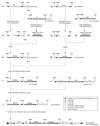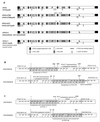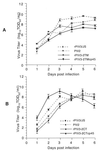Replacement of the ectodomains of the hemagglutinin-neuraminidase and fusion glycoproteins of recombinant parainfluenza virus type 3 (PIV3) with their counterparts from PIV2 yields attenuated PIV2 vaccine candidates
- PMID: 10864657
- PMCID: PMC112153
- DOI: 10.1128/jvi.74.14.6448-6458.2000
Replacement of the ectodomains of the hemagglutinin-neuraminidase and fusion glycoproteins of recombinant parainfluenza virus type 3 (PIV3) with their counterparts from PIV2 yields attenuated PIV2 vaccine candidates
Abstract
We sought to develop a live attenuated parainfluenza virus type 2 (PIV2) vaccine strain for use in infants and young children, using reverse genetic techniques that previously were used to rapidly produce a live attenuated PIV1 vaccine candidate. The PIV1 vaccine candidate, designated rPIV3-1cp45, was generated by substituting the full-length HN and F proteins of PIV1 for those of PIV3 in the attenuated cp45 PIV3 vaccine candidate (T. Tao et al., J. Virol. 72:2955-2961, 1998; M. H. Skiadopoulos et al., Vaccine 18:503-510, 1999). However, using the same strategy, we failed to recover recombinant chimeric PIV3-PIV2 isolate carrying the full-length PIV2 glycoproteins in a wild-type PIV3 backbone. Viable PIV3-PIV2 chimeras were recovered when chimeric HN and F open reading frames (ORFs) rather than complete PIV2 F and HN ORFs were used to construct the full-length cDNA. The recovered viruses, designated rPIV3-2CT, in which the PIV2 ectodomain and transmembrane domain were fused to the PIV3 cytoplasmic domain, and rPIV3-2TM, in which the PIV2 ectodomain was fused to the PIV3 transmembrane and cytoplasmic tail domain, possessed similar in vitro and in vivo phenotypes. Thus, it appeared that only the cytoplasmic tail of the HN or F glycoprotein of PIV3 was required for successful recovery of PIV3-PIV2 chimeras. Although rPIV3-2CT and rPIV3-2TM replicated efficiently in vitro, they were moderately to highly attenuated for replication in the respiratory tracts of hamsters, African green monkeys (AGMs), and chimpanzees. This unexpected finding indicated that chimerization of the HN and F proteins of PIV2 and PIV3 itself specified an attenuation phenotype in vivo. Despite this attenuation, these viruses were highly immunogenic and protective against challenge with wild-type PIV2 in hamsters and AGMs, and they represent promising candidates for clinical evaluation as a vaccine against PIV2. These chimeric viruses were further attenuated by the addition of 12 mutations of PIV3cp45 which lie outside of the HN and F genes. The attenuating effects of these mutations were additive with that of the chimerization, and thus inclusion of all or some of the cp45 mutations provides a means to further attenuate the PIV3-PIV2 chimeric vaccine candidates if necessary.
Figures



Similar articles
-
Generation of a parainfluenza virus type 1 vaccine candidate by replacing the HN and F glycoproteins of the live-attenuated PIV3 cp45 vaccine virus with their PIV1 counterparts.Vaccine. 1999 Oct 14;18(5-6):503-10. doi: 10.1016/s0264-410x(99)00227-3. Vaccine. 1999. PMID: 10519940
-
Recovery of a fully viable chimeric human parainfluenza virus (PIV) type 3 in which the hemagglutinin-neuraminidase and fusion glycoproteins have been replaced by those of PIV type 1.J Virol. 1998 Apr;72(4):2955-61. doi: 10.1128/JVI.72.4.2955-2961.1998. J Virol. 1998. PMID: 9525616 Free PMC article.
-
A live attenuated chimeric recombinant parainfluenza virus (PIV) encoding the internal proteins of PIV type 3 and the surface glycoproteins of PIV type 1 induces complete resistance to PIV1 challenge and partial resistance to PIV3 challenge.Vaccine. 1999 Mar 5;17(9-10):1100-8. doi: 10.1016/s0264-410x(98)00327-2. Vaccine. 1999. PMID: 10195620
-
Current status of vaccines for parainfluenza virus infections.Pediatr Infect Dis J. 2008 Oct;27(10 Suppl):S123-5. doi: 10.1097/INF.0b013e318168b76f. Pediatr Infect Dis J. 2008. PMID: 18820572 Review.
-
Sendai Virus-Vectored Vaccines That Express Envelope Glycoproteins of Respiratory Viruses.Viruses. 2021 May 29;13(6):1023. doi: 10.3390/v13061023. Viruses. 2021. PMID: 34072332 Free PMC article. Review.
Cited by
-
A paramyxovirus-vectored intranasal vaccine against Ebola virus is immunogenic in vector-immune animals.Virology. 2008 Aug 1;377(2):255-64. doi: 10.1016/j.virol.2008.04.029. Virology. 2008. PMID: 18570964 Free PMC article.
-
Heterologous exchanges of the glycoprotein and the matrix protein in a Novirhabdovirus.J Virol. 2002 Mar;76(6):2881-9. doi: 10.1128/jvi.76.6.2881-2889.2002. J Virol. 2002. PMID: 11861855 Free PMC article.
-
Sequence analysis of the Washington/1964 strain of human parainfluenza virus type 1 (HPIV1) and recovery and characterization of wild-type recombinant HPIV1 produced by reverse genetics.Virus Genes. 2002;24(1):77-92. doi: 10.1023/a:1014042221888. Virus Genes. 2002. PMID: 11928991
-
Nonsegmented negative-strand viruses as vaccine vectors.J Virol. 2006 Nov;80(21):10293-306. doi: 10.1128/JVI.00919-06. J Virol. 2006. PMID: 17041210 Free PMC article. Review. No abstract available.
-
Mumps virus matrix, fusion, and nucleocapsid proteins cooperate for efficient production of virus-like particles.J Virol. 2009 Jul;83(14):7261-72. doi: 10.1128/JVI.00421-09. Epub 2009 May 13. J Virol. 2009. PMID: 19439476 Free PMC article.
References
-
- Belshe R B, Hissom F K. Cold adaptation of parainfluenza virus type 3: induction of three phenotypic markers. J Med Virol. 1982;10:235–242. - PubMed
-
- Belshe R B, Mendelman P M, Treanor J, King J, Gruber W C, Piedra P, Bernstein D I, Hayden F G, Kotloff K, Zangwill K, Iacuzio D, Wolff M. The efficacy of live attenuated, cold-adapted, trivalent, intranasal influenzavirus vaccine in children. N Engl J Med. 1998;338:1405–1412. - PubMed
-
- Belshe R B, Van Voris L P, Mufson M A, Buynak E B, McLean A A, Hilleman M A. Comparison of enzyme-linked immunosorbent assay and neutralization techniques for measurement of antibody to respiratory syncytial virus: implications for parenteral immunization with live virus vaccine. Infect Immun. 1982;37:160–165. - PMC - PubMed
-
- Bousse T, Takimoto T, Gorman W L, Takahashi T, Portner A. Regions on the hemagglutinin-neuraminidase proteins of human parainfluenza virus type-1 and Sendai virus important for membrane fusion. Virology. 1994;204:506–514. - PubMed
Publication types
MeSH terms
Substances
Grants and funding
LinkOut - more resources
Full Text Sources
Other Literature Sources
Molecular Biology Databases

